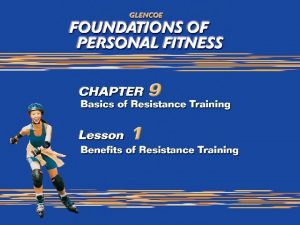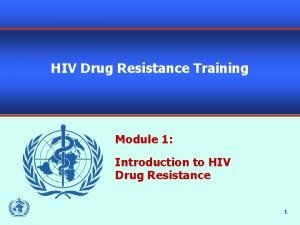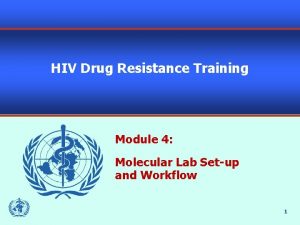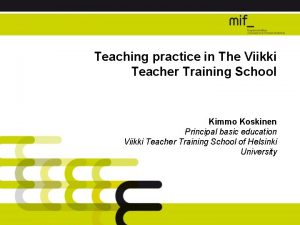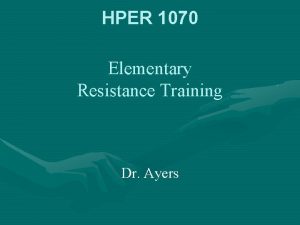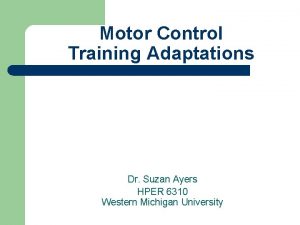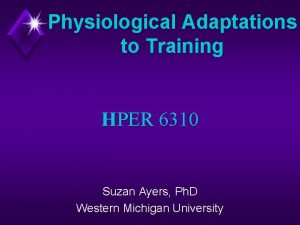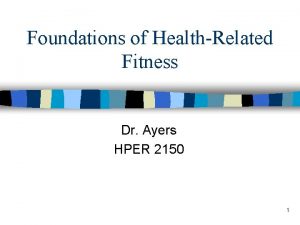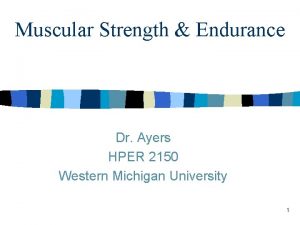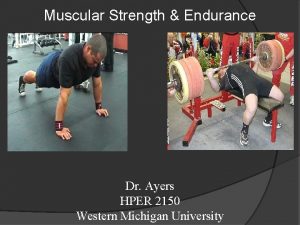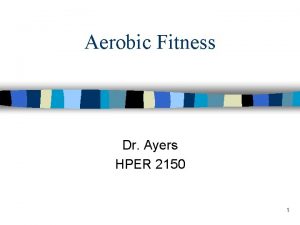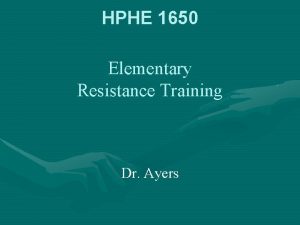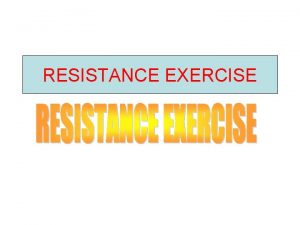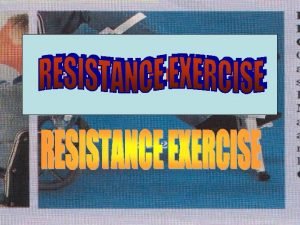HPER 1070 MiddleHigh School Resistance Training Dr Ayers


















- Slides: 18

HPER 1070 Middle/High School Resistance Training Dr. Ayers

Review • Elementary training recommendations (p. 103) • Elementary training methods

Safety Guideline “Lifting maximal weights should be delayed until all the long bones have finished growing at about 17 years of age (older in boys). ” (p. 109)

Postpubescent-Specific Benefits of Resistance Training* • Improved: blood lipid profiles body composition mental health and well-being attitude toward lifetime physical activity

Resistance Training Cautions • Psychological and physical readiness for instruction • Adequate supervision (1 T : 5 -10 S) • Technique and safety for EACH lift emphasized • Avoid machines not designed to fit children • Include resistance training in a well-rounded program • Always warm-up and cool-down • Concentric and eccentric contractions included

Youth Resistance Training Guidelines (p. 98; Faigenbaum, 2007) • Provide qualified instruction & supervision • Ensure safe environment, free of hazards • Begin each session with 5 -10 min. dynamic warm-up • Start: 1 set, 10 -15 reps, moderate load

• Increase resistance GRADUALLY (5 -10%) • Focus on TECHNIQUE, not weight lifted • Train 2 -3 x/wk on non-consecutive days • Use individualized workout logs to monitor progress • Systematically vary program to retain challenge

Table 6. 1 (p. 100) Ages 9 -11 yrs 12 -14 yrs Frequency 2 -3 d/wk Intensity Very light weight Light weight Time 1 set (or 2), 6 -15 reps, 20 -30 mins 1 set (up to 3), 6 -15 reps, 20 -30 mins Type 1 exercise per major muscle group

Youth Resistance Training Recommendations(p. 103) • Start slowly: 1 set, 10 -15 reps, 2 x/wk • Gradually ↑overload to 1 -3 sets, 6 -15 reps, 23 x/wk • ↑training load 5 -10% on most exercises • Emphasize full ROM, enjoyment, fun • Variety is key: change exercises, training

Safety Guideline “Lifting maximal weights should be delayed until all the long bones have finished growing at about 17 years of age (older in boys). ” (p. 109)

Estimating 1 RM SAFETY: Lifting a 1 RM should ABSOLUTELY NOT be used to obtain a training intensity Do NOT expose children to: -loads >70 -80% estimated 1 RM -explosive lifts with free weights Calculate 1 RM from a 6 -12 rep weight or perform 10 RM see p. 102 (T 6. 2)

Manipulating Intensity Strength: ↑weight ↓reps Endurance: ↓weight ↑reps Speed: Focus on full ROM, technique and SLOW movement 2 (concentric) – 1 (pause) – 4 (eccentric)*

Training Methods • Body-weight training • Partner-resisted training – Match height, weight and strength as closely as possible • Alternative equipment (resistance band, medicine ball, kettle bell, and stability ball training) • Weight training* – Introduce exercises one at a time (purpose, technique, spotting) – Show alternative and free weight exercises for each exercise – Reserve machines & barbells for postpubescent

• Plyometrics* – Children can do non-weighted hops, jumps & throws if intensity and volume are carefully monitored – Solid base of strength training needed before participating in plyometrics; start with low-intensity drills

Safety Guidelines for Muscular Strength and Endurance Activities • To determine reps per set: do reps (up to 15) with correct form and use ½ that number as the set size • Because cartilage is not as strong as bone, the growth plates are an area that can be susceptible to injury. If children are taught how to strength-train properly and use appropriate loads, the risk appears to be minimal.

Safety Guideline “Lifting maximal weights should be delayed until all the long bones have finished growing at about 17 years of age (older in boys). ” (p. 109)

Training Students as Spotters • Proper spotting is vital to the overall safety of the person lifting the weight and the effectiveness of incorporating the FITT guidelines. • Several good books exist on weight training that incorporate spotting techniques. • Key elements: 1) spot only weight you can manage, 2) spot only lifts you know, 3) pay attention • The World According to Ayers:

Summary • Teach students the importance of muscular strength and endurance training in safe and effective ways. • Help each student develop an individual plan that includes realistic goals. • Select and adapt activities that meet your students’ needs. The ultimate goal is to produce graduates who take personal responsibility for fitness as a way of life.
 The vapor pressure of pure water at 110 c is 1070 torr
The vapor pressure of pure water at 110 c is 1070 torr Rotary district 1070 conference 2022
Rotary district 1070 conference 2022 Do you enjoy picnic
Do you enjoy picnic Oshs
Oshs Ayers speculum
Ayers speculum Ju ayers
Ju ayers Uluru dreaming story
Uluru dreaming story Jeanne ayers
Jeanne ayers Rusty and the ayres rockettes band members
Rusty and the ayres rockettes band members Cake filtration equation
Cake filtration equation Air resistance
Air resistance Define resistance exercise
Define resistance exercise Drug resistance training
Drug resistance training Drug resistance training
Drug resistance training Peer pressure resistance training
Peer pressure resistance training Training is expensive without training it is more expensive
Training is expensive without training it is more expensive Metode of the job training
Metode of the job training Aggression replacement training facilitator training
Aggression replacement training facilitator training Viikki teacher training school
Viikki teacher training school











